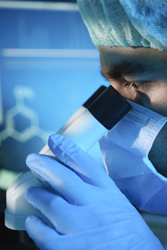Separating mirror image molecules
In chemistry, the handedness of molecules is known as chirality. Chiral drugs may not have the desired effect on the body's own chiral molecules. It is therefore important for scientists to separate, or resolve, the correct form, or enantiomer, from a mixture. Six research teams have recently discovered two new approaches as part of the EU-funded ꞌBottom-up resolution of functional enantiomers from self-organised monolayers (RESOLVE) project. The first approach involves covering a surface in a resolving agent, which has a strong preference for binding only one enantiomer. The enantiomer then sticks, or adsorbs, to that surface. High-powered microscopes are able to confirm this. In the other approach, a crystal is grown on a specially patterned surface that results in a conversion of all the molecules in the liquid to the correct enantiomer. This technique makes use of all of the material that enters the crystallisation reactor, so there is no waste. During the project, researchers were also able to advance a range of analytical tools to characterise very small quantities of crystalline material. This allows for the rapid evaluation of their handedness. These developments will have applications in a number of chemical industries, including the billion euro industry of enantiomer drugs. Of particular importance is the potential to reduce waste when resolving chiral compounds.



